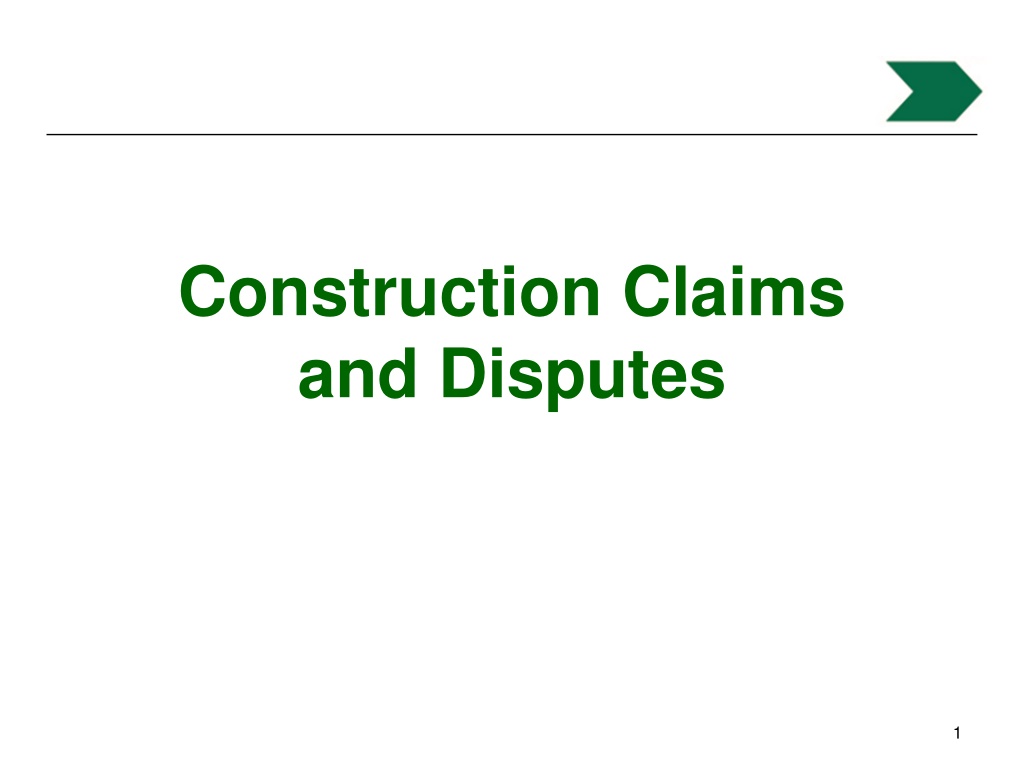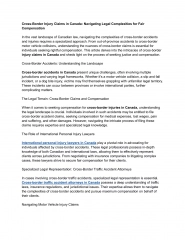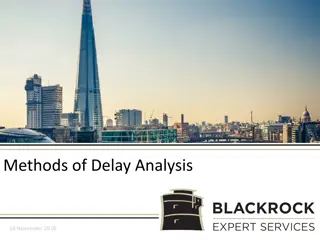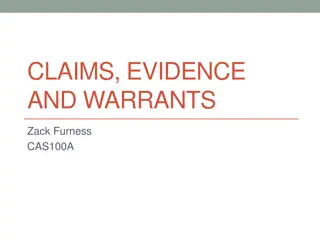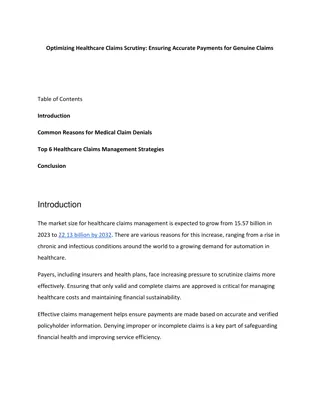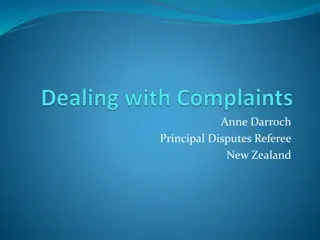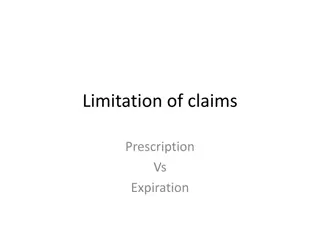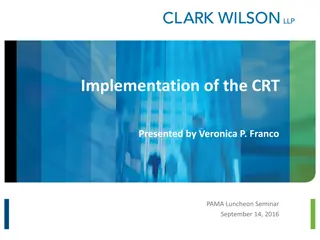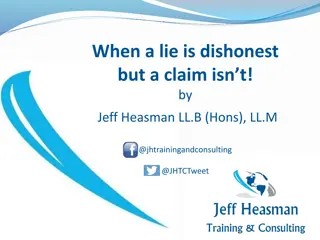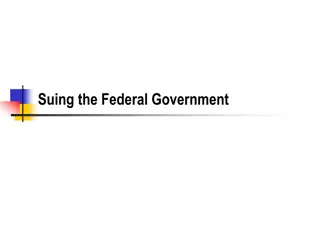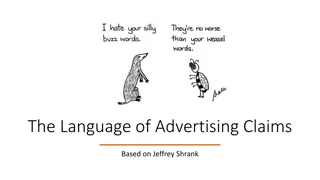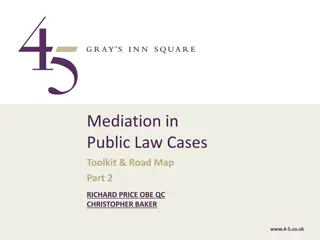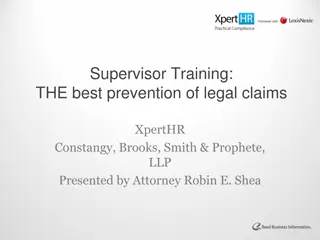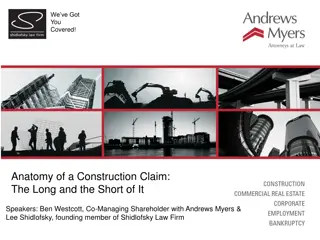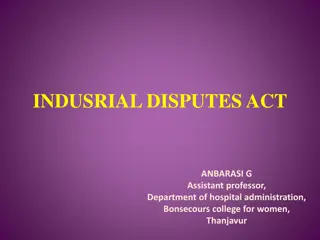Understanding Construction Claims, Disputes, and Legal Responsibilities
Dive into the world of construction claims and disputes with insights on claim definitions, contract components, legal responsibilities such as the Spearin Doctrine, public agency responsibilities, and contractor responsibilities. Learn about the intricacies of resolving potential claims and disputes in construction projects.
Download Presentation

Please find below an Image/Link to download the presentation.
The content on the website is provided AS IS for your information and personal use only. It may not be sold, licensed, or shared on other websites without obtaining consent from the author. Download presentation by click this link. If you encounter any issues during the download, it is possible that the publisher has removed the file from their server.
E N D
Presentation Transcript
Construction Claims and Disputes 1
Claim Definition A Dispute A difference of opinion over the need to revise the contract for: A fair time extension A fair payment for added work A fair payment for unanticipated work 2
Construction Contract Components Project Plans Specific plans drawn for your project Project Specifications General Specifications (Standard Specifications, Greenbook, etc ) applicable to similar projects Special Provisions for your specific project Project Site Information A report of specific site conditions, foundation information, environmental alerts and requirements KNOW THE HIERARCHY 3
Legal Responsibilities Spearin Doctrine United States Supreme Court U.S. vs. Spearin (1918) 248 US 132 The owner impliedly warrants the constructability of the plans and specifications The contractor is liable for defects resulting from the contractor s failure to perform work adhering to the plans and specifications the contractor is not liable for defects caused by mistakes in the owner s plans or specifications 5
Public Agency Responsibilities Create Plans & Specifications a professional contractor will find suitable to bid and build the project Provide bidders with all relevant information to determine the difficulty of construction, the quantity of materials and reasonable time to complete the work Award the contract to the lowest responsible bidder Make the site available in the promised time Provide sufficient supervision to be assured of the quality of the work Make timely payments to the contractor 6
Contractor Responsibilities Perform the work as directed by the contract Perform the work as directed by the Engineer Follow the contract procedures for disputes Comply with all Claim Notice requirements Document time and materials for extra work File timely claims pursuant to the Contract CTSS 5-1.43 Potential Claims and Dispute Resolution 7
Potential Claim Potential Claim Contractor s notification that a claim is probable if resolution is not reached prior to issuing the proposed final estimate (PFE). Notice A (properly noticed) demand for monetary compensation or damages Initial, Supplemental and Full and Final Potential Claim Record notices CTSS 5-1.43 Potential Claims and Dispute Resolution
Types of Claims Contractual Contract Interpretation Disputes Ambiguous parts of plans or specifications Changes in the Work or Materials Contract schedules and updates issues Administrative deductions Quantity disputes 9
Types of Claims Physical Differing site conditions Physical conditions differing materially from any of the following: Contract documents Job site examination Physical conditions of an unusual nature, differing materially from those ordinarily encountered and generally recognized as inherent in the work provided for in the Contract CTSS 4-1.06 Differing Site Conditions 10
Contract Changes Contract Changes and Extra Work By signing the Contract, the Owner, Contractor and all Subcontractors agree: Owner has the right to make Changes Contract dictates the procedure for changing the work and paying for those changes Contractor is required to perform the directive despite disagreements Any change to the contract must have a CO CTSS 4-1.05 Changes and Extra Work
Delay Issues Excusable Delay A Delay to a controlling activity beyond the Contractor s and Owner s control that extends the project scheduled completion date. Inexcusable Delay A Delay to a controlling activity caused by the Contractor or the Owner that extends the project scheduled completion date. Concurrent Delay A Delay to a controlling activity partially caused by both parties
Liability Owner Responsible for Delay when its own actions (or inaction) adversely affect Contractor Owner prevents contractor from proceeding with work (e.g. Change to plans) Owner adds work, but no time Owner impedes contractor s progress Owner does not deliver all areas of the site
Analyze Delay Claims Non-Critical Delay A delay to activities that were never on the critical path Critical Delay A delay that extends the project scheduled completion date Perform Time Impact Analysis as Necessary 14
Subcontractor Issues Subcontractors are Contractor s Agents Subcontractors have no contractual relationship (privity) with the owner Owner communicates officially through the prime contractor COs are issued to the contractor, not the subs Subcontractor claims must pass through the prime contractor 15
Contract Administrative Remedies Does your contract require a Potential Claim Record? Should you remind the contractor that a Potential Claim Record is required? Why would you want to do so? 16
When Potential Claim is Filed Contractor must submit Initial Potential Claim Record within 5 business days of Engineer s response to RFI Review Initial Potential Claim Record ASAP Compare Potential Claim with your contract Discuss issues with contractor and your chain of command Determine merit and need for more information Provide initial written response (within 5 business days) WHO HAS BURDEN OWNER OR CONTRACTOR? 17
Follow Up Potential Claim Record Follow contract specifications for process and timeliness of Supplemental Potential Claim Record and Full and Final Potential Claim Record Follow up your response with additional questions to define the exact problem How will you work on a solution if you don t understand the problem? Remind contractor of its responsibility in your specifications, request backup documentation to support costs claimed Document the potential extra work linked to the Potential Claim 18
Keep Thorough Records Document what you do and why in such a way that it could be easily explained to others Follow your agency s policies whenever possible; however, if deviation is necessary, explain why Follow-up on all final paperwork Take regular photographs and videos
Claim Problem Specifications required contractor to install buried conduit for changeable message sign. Conductors for each circuit in the conduit had to be of different colors. Contractor began installing each circuit with only black wire. Your inspector recorded the contractor s work, but made no mention of the different color requirements. When the contractor was half done, he asked the inspector if everything was OK. The inspector said it looked fine. When the Resident Engineer came by later, he saw the circuits were wired improperly and ordered the contractor to fix them by pulling the wires and replacing one of the black wires in each circuit with a red one. The contractor asked for a CO but was denied. He filed and pursued a claim based on the fact the inspector watched the improper installation and said the wiring was satisfactory. Can field personnel verbally waive the contract requirement? Acoustics, Inc. v. Trepte Construction Co. (1971) 14 Cal.App.3d 887 20
Damages on Claims Actual Expenses Verified time and materials Premium time Estimated Expenses Estimated labor Estimated equipment Stand-by labor Stand-by equipment Loss of efficiency 21
Anticipating Claims Notice Unusual pre-construction questions Unusual volume of contractor correspondence Failure to adhere to schedule Failure to obtain materials Failure to schedule subcontractors Verbal complaints contractor or subcontractors Subcontractor/employee problems Adjacent/concurrent contracts 22
Defending Claims DOCUMENT EVERYTHING The equipment and laborers on the project Take regular photos and videos of the project Be aware of current important activities Be accurate in measurement and payment Read and understand your contract Have timely communications with the contractor Be professional and clear with your expectations 23
The Contractors Production Rate Daily reports Track Production before and after a claimed event Follow man-hours per unit of production Follow Efficiency before and after Use photographs and movies to illustrate the normal activity before and after
Evidence in a Contract Dispute Contract plans and specifications Pre-construction meeting documents Change orders Schedules and monthly updates Daily reports Correspondence (letters and emails) Submittals and RFIs Photographs and videos 25
California Public Records Act (CPRA) Govt. Code 6250-6270 "Public records" includes any writing containing information relating to the conduct of the public's business prepared, owned, used, or retained by any state or local agency regardless of physical form or characteristics.
California False Claims Act (CFCA) Govt. Code 12650 et seq Liability under CFCA: Knowingly presents or causes to be presented a false claim to the state or local agency Knowingly makes or causes to be made or used a false record or statement to get a false claim paid or approved Conspiring to defraud the state or agency by submitting a false claim, or be paid one Delivering less property than stated in the receipt Falsifying a receipt for state or agency property Knowingly buying or taking a pledge of public property from another not authorized to sell or pledge the property Knowingly benefitting from a false claim Benefits from an inadvertent submission of a false claim and fails to disclose the false claim within a reasonable time after discovery 27
Will FHWA Participate in Claim Resolution and Support Costs? Adhere to Contract s Claim Resolution Process At least one to two iterations of process Require Contractor to Meet His/Her Burden - Backup documentation to support specific costs Do Not Settle Prematurely Do not want to set Agency precedent Settlement for Business Reasons Okay AFTER satisfying 1 and 2 Above 28
QUESTIONS??? 29
